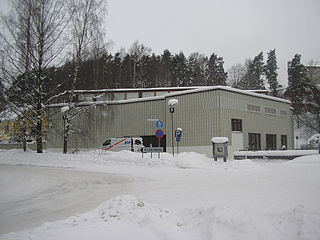 W
WThe Alvar Aalto Museum is a Finnish museum operating in two cities, Jyväskylä and Helsinki, in two locations each. All four locations are open to the public. They are:The Alvar Aalto Museum in Jyväskylä, which is a museum specialised in architecture and design and functions as the national and international centre on all things Aalto. The Muuratsalo Experiential House Villa Aalto in Munkkiniemi, Helsinki Studio Aalto, also in Munkkiniemi, Helsinki
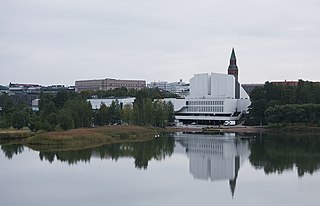 W
WThe Finlandia Hall is a congress and event venue in the centre of Helsinki on the Töölönlahti Bay, owned by the City of Helsinki. The building, which was designed by architect Alvar Aalto, was completed in 1971. Every detail in the building is designed by Aalto. The designs were completed in 1962, with building taking place between 1967–1971. The Congress Wing was designed in 1970 and built in 1973–1975. In 2011, the building was expanded with new exhibition and meeting facilities. Finlandia Hall is known as the venue for the OSCE Summit held in August 1975, attended by 35 world leaders, including the leader of the Soviet Union, Leonid Brezhnev, and the President of the United States, Gerald Ford.
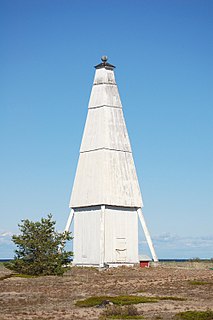 W
WThe Keskiniemi beacon tower, often referred to as the Karvo beacon tower, is a historic daymark located on a promontory of Keskiniemi in the northwestern part of Hailuoto island in the Gulf of Bothnia in Finland. The tower was built in 1858 to alert the vessels about sandbars reaching northwest from the site. It is the oldest surviving navigational aid on Hailuoto island. The tower has structural similarities with the Härkmeri beacon tower built in 1857.
 W
WKuninkaanhauta is a Bronze Age tumulus in the village of Panelia in Eura, Finland, dating back to c. 1500–1300 BC. It is the largest burial cairn in Finland, Kuninkaanhauta is 36×30 meters wide and about four meters high.
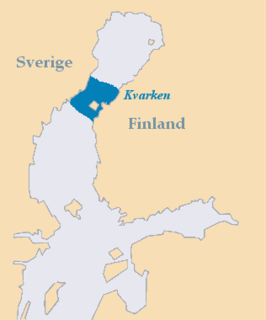 W
WKvarken is the narrow region in the Gulf of Bothnia separating the Bothnian Bay from the Bothnian Sea. The distance from Swedish mainland to Finnish mainland is around 80 km (50 mi) while the distance between the outmost islands is only 25 km (16 mi). The water depth in the Kvarken region is only around 25 metres (82 ft). The region also has an unusual rate of land rising at about 10 mm a year.
 W
WLaitakari beacon tower is a daymark located on the island of Laitakari in the Gulf of Bothnia in Finland. The island is located east-northeast of Hailuoto and is within the municipal boundaries of the City of Oulu. There has been a navigational aid on the island since the 1750s, and a beacon tower has been marked on a chart dated in 1785.
 W
WOld Rauma is the wooden city centre of the town of Rauma, Finland. It is listed as a UNESCO World Heritage Site.
 W
WThe Parliament House is the seat of the Parliament of Finland. It is located in the Finnish capital Helsinki, in the district of Töölö.
 W
WThe Petäjävesi Old Church is a wooden church located in Petäjävesi, Finland. It was built between 1763 and 1765, when Tavastia was still a part of Sweden. The bell tower was built in 1821. It was inscribed in 1994 on the UNESCO World Heritage List.
 W
WSammallahdenmäki is a Bronze Age burial site in Finland in Rauma. It was designated by UNESCO as a World Heritage Site in 1999, and includes 36 granite burial cairns dating back more than 3,000 years, to 1,500 to 500 BC. It is located on a hill in a remote area off the road between Tampere and Rauma. Originally, it was near the coast of the Gulf of Bothnia, but the land has risen so it is now 15 kilometers from the sea. It is one of the most important Bronze Age sites in Fennoscandia.
 W
WSkyWheel Helsinki is a 40-meter tall Ferris wheel in central Helsinki, Finland. One of its gondola cabins, the SkySauna, is the world's first sauna on a Ferris wheel. It opened to the public on June 3, 2014. It was originally named the Finnair SkyWheel and its placement on Katajanokka harbor is where the airline Finnair first located its flight operations in the 1920s.
 W
WStockmann Helsinki Centre is a culturally significant business building and department store located in the centre of Helsinki, Finland. It is one of many department stores owned by the Stockmann corporation. It is the largest department store in the Nordic countries in terms of area and total sales. The store is known for carrying all the internationally recognised luxury brands, and Stockmann's enjoys a reputation as the primary high-end department store in Finland. Stockmann Delicatessen, the food and beverage department located at the basement level, is renowned for the quality and choice of its foodstuffs. The Stockmann logo represents a set of escalators, which are commonly, but wrongly believed represent the first escalators in Finland. The first escalators in Finland were installed in the Forum department store, Turku (1926).
 W
WThe Studio Aalto is a house in the Tiilimäki neighbourhood of Munkkiniemi, Helsinki, which Alvar Aalto designed during 1955–56 to be the studio of his architect bureau. Due to a large number of commissions, the office needed more space in which to work. The studio is said to be one of his best buildings from the 1950s. Near the studio there is also Villa Aalto, the home of the Aaltos. Both the studio and the Villa are now part of the Alvar Aalto Museum, and they are open to the public. The Alvar Aalto Academy and Alvar Aalto Museum Architectural Heritage Department are housed in Studio Aalto.
 W
WSuomenlinna, or Sveaborg (Swedish), is an inhabited sea fortress built on eight islands about 4 km southeast of the city center of Helsinki, the capital of Finland. Suomenlinna is a UNESCO World Heritage site that is popular with tourists and locals, who enjoy it as a picturesque picnic site. Originally named Sveaborg, or Viapori as referred to by Finnish-speaking Finns, it was renamed in Finnish to Suomenlinna in 1918 for patriotic and nationalistic reasons, though it is still known by its original name in Sweden and by Swedish-speaking Finns.
 W
WVerla at Jaala, Kouvola, Finland, is a well preserved 19th century mill village and a UNESCO World Heritage Site since 1996.
 W
WThe Aalto House, the home of Academician Alvar Aalto is located in Munkkiniemi, Helsinki, at 20, Riihitie. The house is part of the Alvar Aalto Museum, which functions in two cities, Jyväskylä and Helsinki. The other location in Helsinki where the museum functions is Studio Aalto, which is located ca. 450 metres from the house, at Tiilimäki 20.
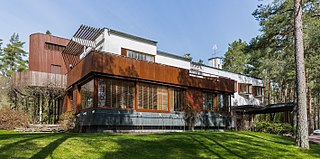 W
WVilla Mairea is a villa, guest-house, and rural retreat designed and built by the Finnish modernist architect Alvar Aalto for Harry and Maire Gullichsen in Noormarkku, Finland. The building was constructed in 1938–1939.